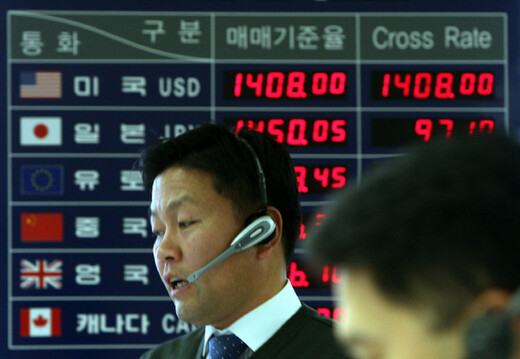hankyoreh
Links to other country sites 다른 나라 사이트 링크
Won drops to below 1,400 per dollar

The South Korean won fell to below 1,400 won in value versus the U.S. dollar two weeks after hitting 1,262 won on November 3. However, daily trading volume on the foreign-exchange market declined to an average of US$2 billion, compared with $5 billion last month when South Korea’s central bank signed a $30 billion swap deal with the U.S. Federal Reserve. It is unusual for the won to continue to fall in value, even though uneasiness about dollar liquidity on the foreign-currency market has lessened, and trading volume has been light.
On the currency market in Seoul, the contrast between the foreign-exchange rate and trading volume became apparent on November 17. The won fell to 1,409 won per dollar, its lowest point since October 29, when it closed at 1,427 won. But daily trading volume totaled $2.55 billion, falling below $3 billion for the third consecutive trading day. With trading on the currency market falling off, the market is losing its ability to function normally. Banks, which were only looking to buy and sell dollars on behalf of their clients, were in a wait-and-see mode.
The reason why the won keeps falling in value is that demand has continued to outpace supply with few signs of changing. Market investors say that fears about a foreign liquidity shortage, which sent local financial markets into a tailspin last month, have eased somewhat, but that with a global economic recession looming, the aversion to risk remains intense. Added to that are questions about whether the fundamentals of the South Korean economy are resilient enough to withstand the downward drag, as local companies, and construction companies in particular, teeter on the edge of bankruptcy. Reflecting those concerns, foreign investors have been a net seller of local stocks since November 11.
The foreign-exchange market is still reeling from a liquidity shortage. Only about 40 percent of foreign debt with a maturity of less than a month has been rolled over.
Meanwhile, trading volume on the foreign-exchange market has been extremely light. Trading volumes averaged at $10 billion a day in the first-half of this year, but fell to $3 billion to $4 billion a day last month. On November 13, the trading volume fell to $2.56 billion for the first time, and continued to fall to $2.34 billion on November 14, representing the lightest trading since December 26, 2005, when trading volume stood at $1.83 billion.
The situation is expected to continue for the time being, people familiar with the foreign-exchange market say. With the fallout from the global credit squeeze, foreign financial companies have refrained from lending dollars before they close their books for the year. What is worse is that it is unlikely the won will be able to stage a turnaround amid the selling spree by foreign investors and concerns about the turmoil in the global financial market. Jo Hee-bong, a deputy manager at Hana Bank, said, “It’s difficult to find factors that would allow for the won to rise in value. The won is likely to fall further in value by the end of the year.”
Of course, the falling won is not likely to spark a rash of dollar hoarding. The government and Bank of Korea are responding to dollar demands by providing dollar liquidity for repayments of foreign debts by banks, imports of raw materials by companies and purchases of corporate notes for exports. However, companies and individuals that are not covered by the government’s foreign-liquidity rescue packages are expected to bear the brunt of the burden imposed by the won’s declining value.
Please direct questions or comments to [englishhani@hani.co.kr]
Editorial・opinion
![[Column] Season 2 of special prosecutor probe may be coming to Korea soon [Column] Season 2 of special prosecutor probe may be coming to Korea soon](https://flexible.img.hani.co.kr/flexible/normal/500/300/imgdb/original/2024/0426/3317141030699447.jpg) [Column] Season 2 of special prosecutor probe may be coming to Korea soon
[Column] Season 2 of special prosecutor probe may be coming to Korea soon![[Column] Park Geun-hye déjà vu in Yoon Suk-yeol [Column] Park Geun-hye déjà vu in Yoon Suk-yeol](https://flexible.img.hani.co.kr/flexible/normal/500/300/imgdb/original/2024/0424/651713945113788.jpg) [Column] Park Geun-hye déjà vu in Yoon Suk-yeol
[Column] Park Geun-hye déjà vu in Yoon Suk-yeol- [Editorial] New weight of N. Korea’s nuclear threats makes dialogue all the more urgent
- [Guest essay] The real reason Korea’s new right wants to dub Rhee a founding father
- [Column] ‘Choson’: Is it time we start referring to N. Korea in its own terms?
- [Editorial] Japan’s rewriting of history with Korea has gone too far
- [Column] The president’s questionable capacity for dialogue
- [Column] Are chaebol firms just pizza pies for families to divvy up as they please?
- [Column] Has Korea, too, crossed the Rubicon on China?
- [Correspondent’s column] In Japan’s alliance with US, echoes of its past alliances with UK
Most viewed articles
- 1‘We must say no’: Seoul defense chief on Korean, USFK involvement in hypothetical Taiwan crisis
- 2N. Korean delegation’s trip to Iran shows how Pyongyang is leveraging ties with Moscow
- 3‘Weddingflation’ breaks the bank for Korean couples-to-be
- 4Korea sees more deaths than births for 52nd consecutive month in February
- 5[Editorial] New weight of N. Korea’s nuclear threats makes dialogue all the more urgent
- 6[Column] Park Geun-hye déjà vu in Yoon Suk-yeol
- 7[Column] Has Korea, too, crossed the Rubicon on China?
- 8[Guest essay] The real reason Korea’s new right wants to dub Rhee a founding father
- 9Will NewJeans end up collateral damage in internal feud at K-pop juggernaut Hybe?
- 10Why Korea shouldn’t welcome Japan’s newly beefed up defense cooperation with US